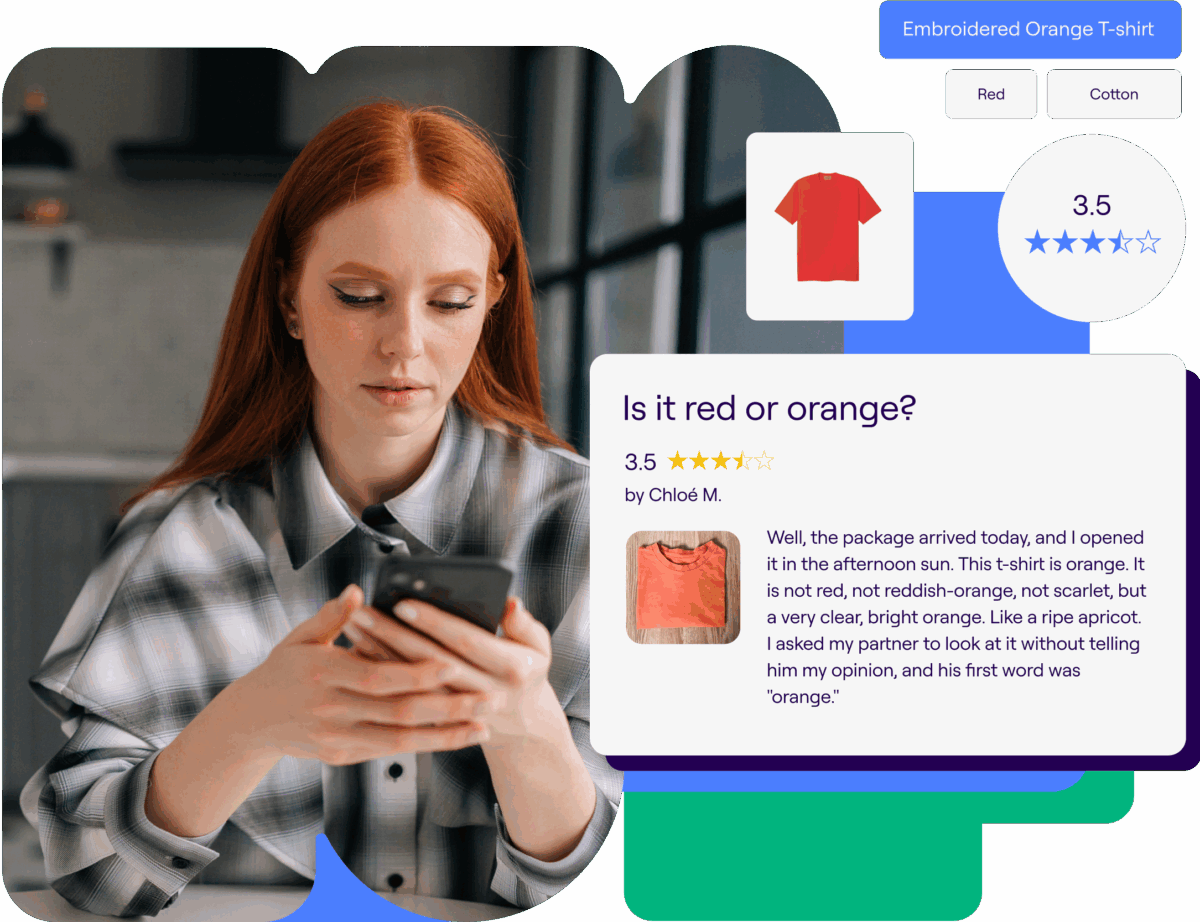See how forward-thinking brands are delivering personalized experiences that go beyond the basics, from AI-driven product recommendations and intuitive site navigation to timely, tailored messaging. Discover why high-quality product data is the foundation for personalization that performs, and how Akeneo Product Cloud empowers businesses to build loyalty and drive sustainable growth.

Table of Contents
Keywords
Do you remember the first time your favorite local coffee shop greeted you by name and started making your usual order before you even asked? That moment felt like exceptional service—but really, it was your first taste of a truly personalized experience.
Today, that same expectation extends far beyond your morning coffee. Consumers don’t want generic messages or one-size-fits-all offers; they expect brands to understand their preferences and anticipate their needs. In fact, our survey found that two in five consumers would pay up to 25% more for a personalized shopping experience.
A personalized experience is any brand interaction that feels intentionally made for an individual customer — based on who they are, what they do, and what they need. Rather than pushing the same products or messaging to everyone, these experiences adjust in real time using customer insights like past purchases, browsing habits, location, or even customer service interactions. This kind of authentic connection makes customers feel recognized and helps deliver a high-quality product experience that builds trust from discovery to post-purchase.
Personalization takes many forms. And each plays a unique role in shaping how individual customers engage with your brand:
Product recommendations are one of the most recognizable and impactful forms of personalized customer experience. Whether it’s the classic “Customers also bought” row or a curated homepage based on your browsing behavior, these dynamic suggestions help guide customers toward relevant products and services they may not have discovered otherwise.
What makes this approach so powerful is its ability to connect customers with offerings that align with their tastes and needs, without having them do the searching themselves. This not only improves product discovery and shortens the path to purchase, but also increases basket size and satisfaction, making customers feel like the brand gets them. For many businesses, product recommendations are a major driver of both loyalty and margin, turning a basic browsing session into a high-value customer interaction rooted in personalization.
Artificial Intelligence (AI) and Machine Learning (ML) sit at the core of modern recommendation engines. These technologies analyze a combination of real-time customer behavior (such as time spent on pages and cart activity) and historical data like past purchases, product ratings, or even abandoned items. By continuously learning from this data, AI models can predict what an individual customer is likely to want next and surface it instantly, whether that’s through the homepage or a Product Detail Page (PDP).
And AI is doing more than just improving the checkout experience; 49% of shoppers say AI-powered recommendations have influenced their purchase decisions. And with ChatGPT’s recent announcement of their “Instant Checkout” feature that allows consumers to purchase products directly within the AI interface, we can only expect this percentage to grow.
Forget mass email campaigns! Today’s customers expect messaging that’s timely and customized to their individual preferences. Personalized messaging, whether through email, SMS, push notifications, or social media, enables brands to speak directly to each customer with content that reflects their interests and position in the purchase journey. From abandoned cart nudges to restock alerts, every touchpoint becomes an opportunity to deepen engagement and drive retention. When personalization efforts are thoughtful and well-timed, they feel like a natural part of the shopping experience. And as customers navigate an expanding landscape of channels and interactions, contextual messaging is essential for delivering a unified and seamless brand experience.
Delivering that level of personalization across multiple touchpoints isn’t easy, especially at scale. That’s where AI makes the difference, helping brands move beyond static segments to build dynamic messaging strategies that respond to customer behavior. With the ability to generate tailored content and adapt on the fly, AI ensures communication stays relevant and contextual. Tools like Akeneo PX Insights play a key role in making this possible by leveraging behavior data to inform smarter decisions within your Product Information Management (PIM). The solution empowers teams to optimize messaging and product content based on how customers actually interact across channels. And by uncovering not just what customers engage with, but why, brands can deliver smarter product experiences grounded in real insights.
AI’s role in performance optimization becomes even more impactful when applied to customer communication. Take Amazon, for example — their AI-powered personalization strategy has transformed how they engage customers through email. By analyzing individual behavior, purchase history, and preferences, Amazon’s machine learning algorithms generate hyper-personalized email content tailored to each recipient. Suppose a customer recently purchased a book by a particular author. In that case, they might receive a follow-up email recommending other titles by the same or similar authors, all automatically curated by AI. This level of intelligent automation drives higher open rates and helps brands maintain consistent, high-value interactions over time.
One of the most underrated forms of personalization is how a customer navigates your digital storefront. Intuitive browsing is about making it easy (even enjoyable!) for customers to find what they’re looking for, or better yet, stumble across something they didn’t know they needed. This involves more than good UX design; it’s about adapting the interface, filters, categories, and search results to match the behavior and preferences of each customer.
A returning visitor might see their favorite categories featured prominently, while a new shopper might be guided through a curated onboarding experience. The goal is to remove friction from the exploration phase of the customer journey and turn it into a satisfying experience that keeps people engaged and encourages repeat visits.
This same intelligence extends beyond messaging, shaping how customers explore and discover products. AI plays a key role in making digital browsing feel more intuitive by adapting interfaces in real time based on user behavior and context. Rather than relying on fixed categories or keyword-matching alone, AI-powered systems use ML and Natural language processing (NLP) to interpret what a customer really means — not just what they type.
Take a search for “lightweight winter jacket.” A traditional search engine might simply pull every item containing those keywords in the title or description. In contrast, AI can analyze customer reviews to identify jackets most often praised for warmth without bulk, recognize which styles perform best in colder climates, and even factor in recent weather trends to promote products that align with real conditions. This level of intelligence helps deliver results that match intent instead of just wording, offering more meaningful and accurate recommendations.
Beyond search results, AI also reshapes the broader browsing experience, adjusting navigation menus and reorganizing category layouts to reflect real-time preferences. Brands like Sephora are already leading the way: after noticing a rise in detailed product searches, they used AI to generate landing pages tailored to queries like “best foundation for sensitive skin.” This not only delivered hyper-relevant content to curious shoppers but also led to a 6% boost in organic search visibility. It’s a perfect example of how AI can power both a smoother browsing journey and smarter product discovery, all while driving measurable results.
Great personalized experiences can only exist because of great data. No matter how sophisticated your AI or how creative your messaging, if the underlying product information is inconsistent or outdated, the experience falls flat. Today’s customers expect detailed product content, and when they get it, they’re more likely to convert and stay satisfied. In fact, 62% of consumers say they’re far more likely to keep a product and feel good about their purchase when the information they received was comprehensive and correct.
Conversely, poor data drives up return rates and eats into margins. And in 2025, nearly a third of consumers reported dissatisfaction with the depth of product information they received, highlighting a growing gap between expectations and reality.
That’s why investing in tools like a PIM is essential. A modern PIM helps centralize product content, ensure consistency across all channels, and scale personalization efforts with confidence. Paired with enrichment capabilities powered by AI, brands can go beyond accuracy and start tailoring experiences for individual shoppers — delivering the right message, with the right information, at exactly the right moment.
And the stakes are high: 77% of shoppers say they would abandon a site and look elsewhere if product details, pricing, or specifications were incomplete. This kind of content-driven personalization not only improves conversions but also reduces costly returns and preserves customer loyalty.
Personalized experiences are grounded in great product data. Without complete, consistent, and context-rich information, even the smartest AI can’t deliver relevance or drive the kind of engagement today’s customers expect! From search to messaging to browsing, every touchpoint depends on the accuracy and depth of your product content.
When the product experience matches the product promise, everyone wins. With the right data foundation in place, supported by tools like PIM and enriched by AI, personalization becomes the best thing a business could have: a sustainable growth strategy.
Discover what global consumers revealed about their evolving expectations and why better product information, not just better tech, is the key to winning hearts, sales, and loyalty.
